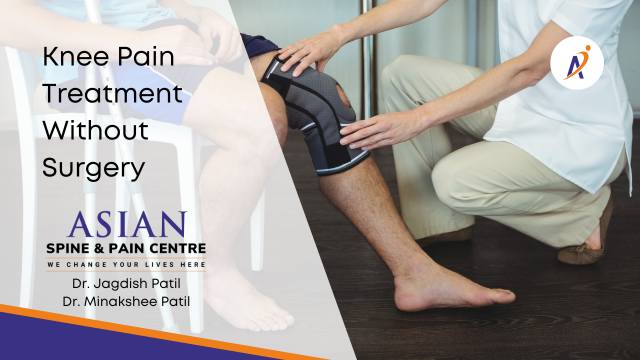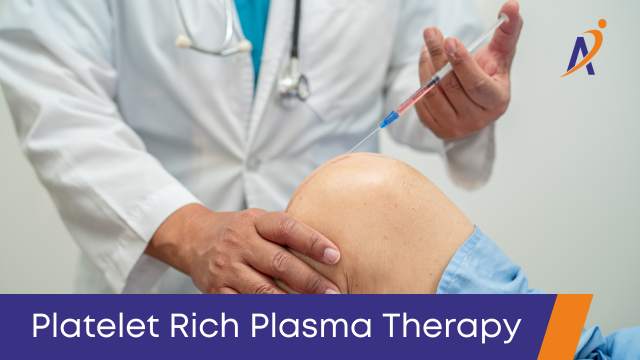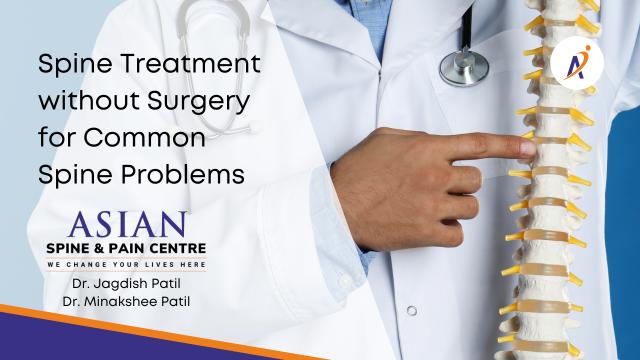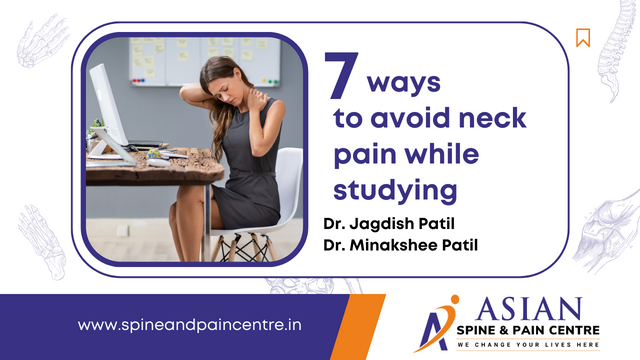Dr. Jagdish Patil & Dr. Minakshee Patil provides spine treatment without Surgery for common spine problems like spinal stenosis, herniated disc, sciatica, arthritis in Pune.
Knee pain is a common complaint affecting people of all ages in India. While surgery is sometimes necessary, there are various non-surgical treatment options available for managing knee pain effectively. In this blog, we will explore the symptoms, prevalence, causes, and non-surgical treatment options for knee pain in India. At Asian Spine & Pain Centre, Dr. Jagdish Patil provides knee pain treatment without surgery in Pune. Here we have avoided over 95% surgeries in patients with Knee Pain.
Several factors can contribute to knee pain. Some common causes include:
Osteoarthritis: The most common cause of knee pain, especially in older individuals, is the degeneration of joint cartilage.
Ligament Injuries: Tears or strains in the ligaments supporting the knee, such as the ACL or MCL, can lead to knee pain.
Meniscus Tears: Damage to the meniscus, the cushioning cartilage in the knee joint, can cause pain and limited mobility.
Patellofemoral Pain Syndrome: This condition involves pain and inflammation in the front of the knee, often due to overuse or misalignment.
Bursitis: Inflammation of the bursae, small fluid-filled sacs that cushion the knee joint, can result in knee pain.
Tendonitis: Inflammation of the tendons, such as the patellar tendon, can cause pain and difficulty in knee movement.
Knee pain can manifest in different ways, including:
- Persistent pain, either dull or sharp, in the knee joint.
- Swelling and inflammation around the knee.
- Limited range of motion and difficulty in walking or bending the knee.
- Stiffness and a feeling of instability in the knee joint.
- Grating or popping sounds during movement.
People above age group 50 years suffer from osteoarthritis of some degree. And around 60% of them require medical intervention above age 65 years.
Is Surgery the only option for knee pain?
Absolutely No. More than 95% patients don’t require knee replacement surgery for above common knee problems. These common knee problems can be treated with physical therapy, exercises, diet modifications and non-surgical pain treatments.
What are the non surgical treatment options for knee pain?
Fortunately, many cases of knee pain can be effectively managed without resorting to surgery. Some non-surgical treatment options include:
Medications: Over-the-counter pain relievers, nonsteroidal anti-inflammatory drugs (NSAIDs), and corticosteroid injections can help alleviate knee pain and reduce inflammation.
Physical Therapy: Targeted exercises, stretches, and techniques prescribed by a physiotherapist can improve knee strength, flexibility, and stability.
Weight Management: Maintaining a healthy weight can reduce the stress on the knee joints and alleviate pain.
Assistive Devices: Using knee braces, orthotics, or walking aids can provide support and stability to the knee, reducing pain during movement.
Lifestyle Modifications: Incorporating low-impact exercises, such as swimming or cycling, and avoiding activities that exacerbate knee pain can be beneficial.
Platelet Rich Plasma Therapy: It is one of the very successful regenerative therapies. The platelets in your blood contain growth factors. Injecting PRP growth factors from your own blood into an injured area will help tissues repair themselves by causing new cells to form. In this way, PRP could help reverse existing tissue damage.
Ozone therapy: ozone has both regenerative and anti-inflammatory properties. Ozone connects to the free radicals in your body, acts as an antioxidant, and reduces oxidative stress. It’s the oxidative stress that causes many of the illnesses in our bodies. It also causes the process of aging because the free radicals can cause damage at the cellular level. By using ozone as a regenerative medical treatment, the ability to slow or stop aging is key. It’s one of nature’s anti-aging treatments.
At Asian Spine & Pain Centre, Dr. Jagdish Patil & Dr. Minakshee Patil provides knee pain treatment without Surgery such as platelet rich plasma therapy & ozone therapy.
Asian Spine & Pain Centre is one of the leading pain clinics in India for pain management for common orthopedic problems and other problems like, headaches, cancer pain, sports injuries, joint pain etc.
Asian
Spine And Pain Centre
Asian Spine And Pain Centre
We change your lives here!
Dr. Jagdish Patil
M.B.B.S., M.S.(Orth), FIIPM, FIMISS
Endoscopic Spine & Joint Replacement Surgeon
Pain management Expert
Dr. Minakshee Patil
M.B.B.S., M.D., FPCI, FIPM
Interventional Pain Management Expert
Latest articles
Dr. Jagdish Patil & Dr. Minakshee Patil provides spine treatment without Surgery for common spine problems like spinal stenosis, herniated disc, sciatica, arthritis in Pune.
Follow these 7 simple steps suggested by best pain management expert, Dr. Jagdish Patil, to avoid neck pain while studying long hours.
“World Class Super Speciality Centre for Spine, Joints, Pain & Regenerative Therapies”
Let's Connect
+91-7218113113
Main Clinic
304, 3rd Floor, Choice ‘C’ Apartment, Opp. Millennium Star building, Near Ruby Hall Clinic, Pune 411001.
Send A Mail
Our facilities
Physiotherapy
Procedure Room
Pharmacy
X-ray & Imaging room
Emergency Care
Online Consultancy
FAQs:
Yes, in more than 90% cases with chronic knee pain, a noninvasive or minimal invasive procedures can be used to avoid surgeries. But in 10% cases, surgery is unavoidable and can provide long term benefit. So trust our experts at Asian Spine & pain Centre to provide accurate diagnosis and pain management treatment for your chronic knee pain.
The goal / aim of sports medicine is to maintain, sustain, and at times to regain peak physical fitness i.e., adaptability to stress, physical and mental. Main functions of sports medicine are promotive, educative, formative, recreative, competitive, therapeutic and rehabilitative in nature. At Asian Spine & Pain Centre, we provide complete care of sport sports injuries for athletes in Pune.
Yes, in most cases, physiotherapy is must to regain complete joint mobility and muscular strength. It can be required after any orthopedic treatment either surgical or non-surgical. At Asian Spine & pain Centre, we have a tea, of experienced physiotherapists to provide complete care.
You might have serious back problem or emergency for which you need immediate orthopedic care. Following signs can help you to identify these serious situations – Sharp pain rather than a dull ache, Radiating pain, Sudden weakness in the legs, incontinence, numbness or needle like pain in the groin.
Yes. X-rays are often a good tool for determining if arthritis exists and, specifically, what type. Common types of arthritis include rheumatoid arthritis, psoriatic arthritis, and osteoarthritis. Early in the disease process, more sophisticated imaging may be necessary, especially MRI. We do provide X-ray imaging services at Asian Spine & Pain Centre.
If you’re experiencing chronic pain, a doctor may recommend that you have a nerve block, a temporary or permanent procedure that disrupts specific nerve activity. It can help diagnose or treat certain types of neuropathic pain, or pain caused by nerve dysfunction or damage. At Asian Spine & pain centre, we use nerve block therapy in selected cases of chronic pain.
As is often the case, recovery time can vary from person to person depending on the location of the surgery, the type of surgery required and the lifestyle of the patient. However, most patients are able to leave the hospital the same day and are typically able to return to their active lives within 4-6 weeks after surgery. However, some are back to normal in 1-2 weeks.
You shouldn’t downhill ski or play contact sports such as football and soccer. In general, avoid sports that require jerking, twisting, pulling, or running. You should be able to do lower-impact activities, such as hiking, gardening, swimming, playing tennis, and golfing.
Arthroscopy is a procedure for diagnosing and treating joint problems. A surgeon inserts a narrow tube attached to a fiber-optic video camera through a small incision — about the size of a buttonhole. The view inside your joint is transmitted to a high-definition video monitor. Arthroscopy allows the surgeon to see inside your joint without making a large incision. Surgeons can even repair some types of joint damage during arthroscopy, with pencil-thin surgical instruments inserted through additional small incisions.




